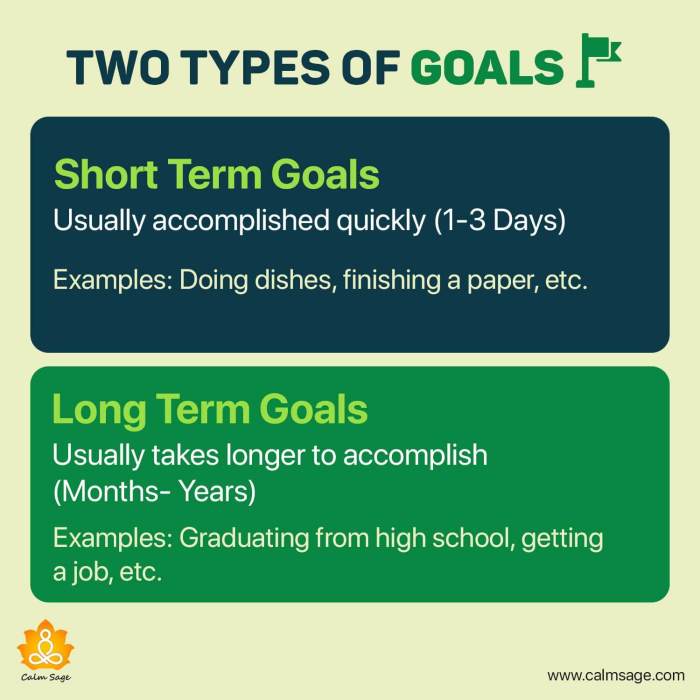How to Achieve 5 of Your Goals in 1 Year delves into strategies for setting SMART goals, prioritizing effectively, creating action plans, tracking progress, and overcoming challenges. This comprehensive guide offers valuable insights on achieving multiple goals within a year.
Exploring the key aspects of goal achievement, this guide provides practical tips and examples to help individuals enhance their goal-setting skills and stay motivated throughout the journey.
Setting SMART Goals

Setting goals is essential for achieving success, but not all goals are created equal. SMART goals are specific, measurable, achievable, relevant, and time-bound. This framework helps individuals set clear objectives and create a roadmap for success.
Specific
- Example: Increase monthly sales by 20%.
- Explanation: Instead of a vague goal like “increase sales,” this goal specifies the target – a 20% increase in monthly sales.
Measurable
- Example: Lose 10 pounds in 3 months.
- Explanation: This goal is measurable as it provides a clear target to track progress – losing 10 pounds within a specific timeframe.
Achievable
- Example: Complete a certification course in your field within 6 months.
- Explanation: This goal is achievable as it is realistic and within reach, considering the time frame and resources available.
Relevant
- Example: Launch a new product line that complements existing offerings.
- Explanation: This goal is relevant to the overall business strategy and aligns with the company’s objectives.
Time-bound
- Example: Save $5,000 for a vacation in one year.
- Explanation: This goal is time-bound, with a specific deadline of one year to save the targeted amount for the vacation.
Setting SMART goals provides clarity, focus, and motivation to work towards achieving specific objectives. By following this framework, individuals can track progress, stay accountable, and ultimately increase the chances of success in reaching their goals.
Prioritizing Goals
Effective goal setting involves prioritizing your goals to ensure focus and productivity in achieving them. By ranking your goals based on importance and urgency, you can allocate your time and resources efficiently to make significant progress.
Strategies for Prioritizing Goals
- Consider the impact: Evaluate the potential impact of each goal on your life or business. Focus on goals that will bring the most significant positive change.
- Deadline-driven approach: Prioritize goals with closer deadlines to prevent procrastination and ensure timely completion.
- Align with values: Choose goals that align with your values and long-term objectives to maintain motivation and commitment.
- Break down complex goals: Divide complex goals into smaller, manageable tasks and prioritize them based on their contribution to the overall goal.
- Assess resources: Identify the resources required for each goal and prioritize based on the availability of resources.
Importance of Prioritization in Goal Achievement
Prioritizing goals is crucial for effective time management and resource allocation. It helps you focus on what truly matters and prevents you from spreading yourself too thin across multiple objectives.
Examples of Prioritizing Goals for Better Focus and Productivity
| Goal | Priority |
|---|---|
| Launch new product | High |
| Attend industry conference | Medium |
| Improve customer service | High |
| Complete professional certification | High |
| Organize team-building event | Low |
Creating Action Plans

Creating action plans is crucial when working towards achieving your goals as it helps you break down your goals into manageable steps, keeping you focused and motivated throughout the process.
Importance of Action Plans
Action plans provide a roadmap that guides you on what specific actions you need to take to reach your goals. By breaking down your goals into smaller tasks, you can track your progress more effectively and make adjustments as needed.
- Set specific and measurable tasks: Define clear and measurable actions that need to be taken to achieve each goal.
- Assign deadlines: Establish timelines for each task to keep yourself accountable and ensure progress is made consistently.
- Identify resources needed: Determine what resources, whether it be time, money, or skills, are required for each task.
- Track progress: Regularly review and update your action plan to monitor your progress and make any necessary changes.
Breaking Down Goals into Actionable Steps
To break down your goals into actionable steps, follow these tips:
- Start with the end goal in mind: Clearly define what you want to achieve.
- Identify main tasks: Break down your goal into smaller, manageable tasks.
- Set priorities: Determine which tasks are most important and should be done first.
- Assign deadlines: Establish realistic timelines for each task to stay on track.
- Allocate resources: Identify what resources you need for each task, such as time, money, or skills.
Examples of Action Plans
Here are examples of action plans for different types of goals:
| Goal | Action Plan |
|---|---|
| Personal: Lose 10 pounds in 3 months | – Join a gym and work out 3 times a week
|
| Professional: Get a promotion within the year | – Update resume and LinkedIn profile
|
| Health: Run a 5k race in 2 months | – Start a running program and gradually increase distance
|
Tracking Progress

Tracking progress towards your goals is crucial for staying motivated and on track. It allows you to see how far you’ve come and what still needs to be done to achieve your objectives.
The Importance of Tracking Progress
Monitoring and measuring progress helps you stay focused and accountable. It allows you to make adjustments to your action plans if needed and ensures that you are moving in the right direction.
- Set specific milestones to track your progress regularly.
- Use a progress journal or online tools to record your achievements and setbacks.
- Celebrate small wins along the way to keep yourself motivated.
Tools and Techniques for Tracking Progress
There are various tools and techniques you can use to monitor and measure your progress towards your goals:
- Goal tracking apps: Utilize apps like Trello, Asana, or Todoist to track your goals and progress.
- Visual aids: Create a vision board or progress chart to visually see your advancements.
- Regular check-ins: Schedule weekly or monthly check-ins to review your progress and adjust your action plans accordingly.
Benefits of Tracking Progress, How to Achieve 5 of Your Goals in 1 Year
Tracking progress not only helps you stay motivated but also provides the following benefits:
- Increased productivity: By monitoring your progress, you can identify areas where you need to improve and focus your efforts.
- Accountability: Tracking progress holds you accountable for your goals and actions, pushing you to work harder towards achieving them.
- Improved decision-making: Regularly reviewing your progress allows you to make informed decisions and adjustments to your strategies.
Overcoming Challenges

When working towards achieving your goals, it’s common to face various challenges that can hinder your progress. However, with the right strategies and mindset, you can overcome these obstacles and stay resilient on your journey to success.
Identifying Common Challenges
Many people face challenges such as lack of motivation, time constraints, fear of failure, and external distractions when trying to achieve their goals. These obstacles can make it difficult to stay focused and committed to your objectives.
Strategies for Overcoming Obstacles
- Break down your goals into smaller, manageable tasks to avoid feeling overwhelmed.
- Seek support from friends, family, or a mentor to help you stay accountable and motivated.
- Practice self-care and stress management techniques to maintain a healthy mindset and energy levels.
- Stay adaptable and be willing to adjust your action plans if unexpected challenges arise.
The Role of Mindset and Perseverance
Your mindset plays a crucial role in overcoming challenges and achieving your goals. By cultivating a positive and growth-oriented mindset, you can approach obstacles as opportunities for growth and learning. Perseverance is also key – staying determined and resilient in the face of setbacks will ultimately lead you to success.
Epilogue: How To Achieve 5 Of Your Goals In 1 Year

In conclusion, mastering the art of goal achievement requires a combination of planning, dedication, and resilience. By following the Artikeld strategies and staying focused on your objectives, you can transform your aspirations into reality and make significant progress in just one year.